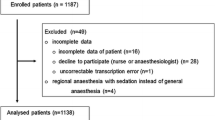Summary
Hypoxaemia may cause postoperative confusion after operations for hip fractures in elderly patients. Twenty-two consecutive patients, with a median age of 73 years, had fractures fixed with a sliding hip screw within 48 hours of admission. The incidence of hypoxaemia was investigated post-operatively using a pulse oximeter. We have demonstrated that this complication occurs frequently on the first day and severe hypoxaemia can be prevented by supplementary oxygen therapy. Our results support the hypothesis that postoperative confusion can be caused by hypoxaemia.
Résumé
L'hypoxémie peut entraîner une confusion postopératoire, situation souvent rencontrée chez les patients âgés victimes d'une fracture de la hanche. Dans cette étude nous analysons la fréquence et la sévérité de l'hypoxémie consécutive au traitement chirurgical de ces fractures. Vingt-deux patients, d'un âge moyen de 73 ans, ont été opérés pour fracture de la hanche, dans les 48 heures suivant leur admission, par vis à compression (système AO). Ils ont ensuite été surveillés pendant la période post-opératoire à l'aide d'un oxymètre. Tous les sujets présentaient une saturation pré-opératoire en oxygène d'au moins 90% et un bilan cardio-pulmonaire normal. Les observations effectuées se poursuivirent pendant 24 heures dans notre service, après la période passée en réanimation. Sur les 22 patients examinés, 21 présentèrent une hypoxémie après 632 minutes (en moyenne), soit 43% du temps d'observation, avec une saturation en oxygène entre 80 et 90%. Sur ces 21 patients, six avaient une saturation en oxygène au dessous de 80% après 6 minutes (en moyenne). Cette désaturation survenait essentiellement la nuit. Neuf patients présentèrent une confusion post-opératoire et trois d'entre eux une désaturation concommitante sévère. Six patients atteints de confusion reçurent un apport supplémentaire d'oxygène, qui entraîna un retour à la normale chez quatre d'entre eux. Nous en concluons que l'hypoxémie est fréquente au cours du premier jour suivant l'intervention chirurgicale, et qu'un apport supplémentaire d'oxygène peut prévenir une hypoxémie sévère. Nos résultats confirment l'hypothèse selon laquelle la confusion post-opératoire pourrait être due à une hypoxémie.
Similar content being viewed by others
References
Berggren D, Gustafson Y, Eriksson B, Bucht G, Hansson L-I, Reiz S, Winblad B (1987) Postoperative confusion after anaesthesia in elderly patients with femoral neck fractures. Anesth Analg 66: 497–504
Borgquist L, Lindelöw G, Thorngren K-G (1991) Costs of hip fracture. Rehabilitation of 180 patients in primary health care. Acta Orthop Scand 62: 39–48
Catley DM, Thornton C, Jordan C, Lehane JR, Royston D, Jones JG (1985) Pronounced, episodic oxygen desaturation in the postoperative period: its association with ventilatory pattern and analgesic regimen. Anesthesiology 63: 20–28
Comroe JH, Botelho S (1947) The unreliability of cyanosis in the recognition of arterial anoxemia. Am J Med Sci 214: 1–6
Craig DB (1981) Postoperative Recovery of Pulmonary Function. Anesth Analg 60: 46–52
Dyson A, Henderson AM, Chamley D, Campbell ID (1988) An assessment of postoperative oxygen therapy in patients with fractured neck of femur. Anaesth Intens Care 6: 405–410
Hole A, Terjesen T, Breivik H (1980) Epidural versus general anaesthesia for total hip arthroplasty in elderly patients. Acta Anaesth Scand 24: 279–287
Jarnlo G-B, Jakobsson B, Ceder L, Thorngren K-G (1989) Hip fracture incidence in Lund, Sweden, 1966–1986. Acta Orthop Scand 60: 278–282
Jones JG, Sapsford JD, Wheatley RG (1990) Postoperative hypoxaemia: mechanisms and time course. Anaesthesia 45: 566–573
Jones JG, Scudder C, Barrowcliffe M, Jordan C, Rocke DA (1985) Episodic postoperative oxygen desaturation: the value of added oxygen. J R Soc Med 78: 1019–1022
Kelleher JF (1989) Pulse oximetry. J Clin Monit 5: 37–62
Knudsen J (1970) Duration of hypoxaemia after uncomplicated upper abdominal and thoraco-abdominal operations. Anaesthesia 25: 372–377
Marshall BE, Wyche MQ (1972) Hypoxemia during and after anesthesia. Anesthesiology 37: 178–209
Moller JT, Wittrup M, Johansen SH (1990) Hypoxemia in the postanaesthesia care unit: an observer study. Anesthesiology 73: 890–895
Rehnberg L, Olerud C (1990) Incidence of hip fractures in elderly: Uppsala County 1980–1987. Acta Orthop Scand 61: 148–151
Rosenberg J, Dirkes WE, Kehlet H (1989) Episodic arterial oxygen desaturation and heart rate variations following major abdominal surgery. Br J Anaesth 63: 651–654
Tremper KK, Barker SJ (1989) Pulse oximetry. Anesthesiology 70: 98–108
Author information
Authors and Affiliations
Rights and permissions
About this article
Cite this article
Krasheninnikoff, M., Ellitsgaard, N., Rude, C. et al. Hypoxaemia after osteosynthesis of hip fractures. International Orthopaedics 17, 27–29 (1993). https://doi.org/10.1007/BF00195219
Issue Date:
DOI: https://doi.org/10.1007/BF00195219




